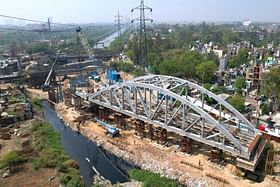This is the only place on the entire RRTS corridor, where such a long viaduct is being constructed with steel spans.
Out of the six, the first special steel span has been successfully installed.
National Capital Region Transport Corporation (NCRTC) is going to install six steel spans to cross the Ghazipur drain on the Delhi-Ghaziabad-Meerut RRTS corridor.
The Regional Rapid Transit System (RRTS) corridor is progressing parallel to the Ghazipur drain. The special steel spans, being installed where the corridor will cross the drain, will also cross over the road near Kondli Chowk.
Out of these six special steel spans, the length of three spans will be approximately 70 m each and the remaining three will be 50 m each. The combined length of these six special steel spans is 350 m.
This is the only place on the entire RRTS corridor, where such a long viaduct is being constructed with steel spans.
Out of these six, the first special steel span has been successfully installed. This special steel span, weighing 560 tonnes has been installed in the Kondli area, near the New Ashok Nagar RRTS station.
The span installed parallel to the Ghazipur drain is about 70 m long and 14 m wide. It was placed on the pillars, at a height of about 6 m from the ground level with the help of big cranes. Another five spans to be installed in the area are under construction.
NCRTC usually erects pillars at an average distance of 34 m for the construction of an elevated viaduct of the RRTS corridor.
These pillars are joined by pre-cast segments with the help of a launching gantry (Tarini) to form the RRTS viaduct span.
However, in some complex areas where the corridor is crossing rivers, bridges, rail crossings, metro corridors, expressways or other such existing infrastructure, it is practically not possible to maintain this distance between pillars. In such areas, steel spans are being used to connect the pillars.
Special steel spans are massive structures, consisting of beams made of structural steel. Segments of structural steel are first manufactured in the factory and then laden onto trailers and brought to the site during the night to avoid any traffic problems.
These parts are then assembled at the site by systematically joining together, with the help of a special process. The shape and structure of these steel spans are specially designed to suit all the requirements of construction, installation, and usage.
The NCRTC team, following all the norms and taking all the precautions has completed the installation of the first steel span near the Ghazipur drain successfully.
NCRTC also took the co-operation of other departments for the installation, and despite many challenges, it has maintained the pace of construction, stated the officials.
So far six special steel spans have been installed on the Delhi Meerut RRTS corridor, including a 50-m-long span at Meerut on the Delhi-Meerut Expressway (DME), a 73-m-long special span at Vasundhara on the main line of the railway, a 150-m-long span near Ghaziabad station, two 45-m-long steel spans for RRTS viaduct going towards Duhai Depot and a 73-m-long span for crossing EPE.
NCRTC aims to operationalise the entire 82-km-long Delhi-Ghaziabad-Meerut corridor for the public by the year 2025.


